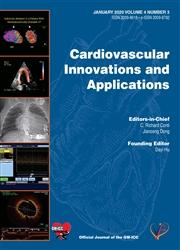Expression Patterns and Functions of Cardiac Pigment Epithelium-Derived Factor During Cardiac Development
IF 0.9
4区 医学
Q4 CARDIAC & CARDIOVASCULAR SYSTEMS
引用次数: 0
Abstract
Objective: This study describes the expression profiles and roles of cardiac pigment epithelium-derived factor (PEDF) during cardiac development. Methods: Gene datasets from the Gene Expression Omnibus (GEO) database were used to analyze the correlation between cardiac PEDF expression and heart disease. Western blotting, immunohistochemistry, histological staining and echocardiography were used to assess the expression patterns and functions of PEDF during cardiac development. Results: Analysis of GEO data sets indicated that the expression of cardiac PEDF correlated with the occurrence and development of various heart diseases. Western blotting of various tissues in mice at 30 postnatal days of age indicated higher PEDF expression in the heart and aorta than the liver. Immunohistochemical results demonstrated that the expression of cardiac PEDF significantly decreased after birth, mainly because of a significant decrease in PEDF expression in the cytoplasm. Histological staining and echocardiography indicated that PEDF deficiency had no significant effects on cardiac structure, cardiac function and vascular hemodynamics in 8-week-old mice. Conclusion: Cardiac PEDF shows high expression and dynamic changes during cardiac development, but has no effects on cardiac structure, function and vascular hemodynamics.心脏色素上皮衍生因子在心脏发育过程中的表达模式和功能
目的:研究心脏色素上皮衍生因子(PEDF)在心脏发育过程中的表达谱及其作用。方法:利用基因表达综合数据库(Gene Expression Omnibus, GEO)中的基因数据,分析心脏PEDF表达与心脏病的相关性。采用Western blotting、免疫组化、组织学染色、超声心动图等方法评价PEDF在心脏发育过程中的表达模式和功能。结果:GEO数据集分析表明,心脏PEDF的表达与各种心脏疾病的发生和发展相关。出生后30日龄小鼠各种组织的Western blotting显示,PEDF在心脏和主动脉中的表达高于肝脏。免疫组化结果显示,出生后心脏PEDF的表达明显下降,主要是由于细胞质中PEDF的表达明显减少。组织学染色和超声心动图显示,PEDF缺乏对8周龄小鼠心脏结构、心功能和血管血流动力学无明显影响。结论:心脏PEDF在心脏发育过程中表现出高表达和动态变化,但对心脏结构、功能和血管血流动力学没有影响。
本文章由计算机程序翻译,如有差异,请以英文原文为准。
求助全文
约1分钟内获得全文
求助全文
来源期刊

Cardiovascular Innovations and Applications
CARDIAC & CARDIOVASCULAR SYSTEMS-
CiteScore
0.80
自引率
20.00%
发文量
222
 求助内容:
求助内容: 应助结果提醒方式:
应助结果提醒方式:


